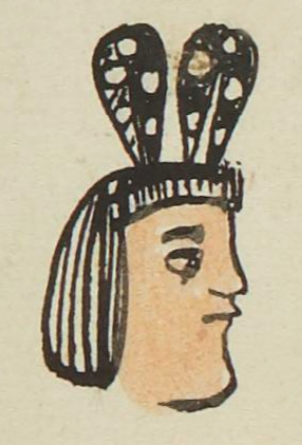Cuazol (MH514r)
This drawing of the simplex glyph for the name Cuazol has two quail (zolin) feathers standing up on the head (cua-) of the portrait of the man whose name this is. The name might be translated as Head-Quail. The man is shown in profile looking toward the viewer's right. His face has been painted a flesh tone.
Stephanie Wood
These dramatic feathers seem to come from the so-called Montezuma Quail. The white dots on a black background recall the glyphic representations of stars in the night sky, which is just the beginning of the association with the celestial realm. Quails were birds that were sacrificed to the sun. Quails were also beheaded to Macuilxochitl and Xochipilli. [See: James Maffie 2014, 216, 384.]
Their remains are very prevalent in the finds at the Templo Mayor, and they are prominent in the Mixtecs' Codex Nuttall. For further information see Elena Mazzetto, "Quail in the Religious Life of the Ancient Nahuas", en Milbrath, Susan y Elizabeth Baquedano (coords.), 2023, Birds and Beasts of Ancient Mesoamerica. Animal Symbolism in the Postclassic Period, Denver, University Press of Colorado, pp. 200-219.
Stephanie Wood
peo guaçol
Pedro Cuazol
Stephanie Wood
1560
Jeff Haskett-Wood and Stephanie Wood
pájaros, codornices, birds, sacrifice, offerings, feathers, plumas

cua-, relating to the head, https://nahuatl.wired-humanities.org/content/cua-2
zol(in), quail, https://nahuatl.wired-humanities.org/content/zolin
Cabeza de Codorniz
Matrícula de Huexotzinco, folio 514r, World Digital Library, https://www.loc.gov/resource/gdcwdl.wdl_15282/?sp=107&st=image
This manuscript is hosted by the Library of Congress and the World Digital Library; used here with the Creative Commons, “Attribution-NonCommercial-ShareAlike 3.0 License” (CC-BY-NC-SAq 3.0).





